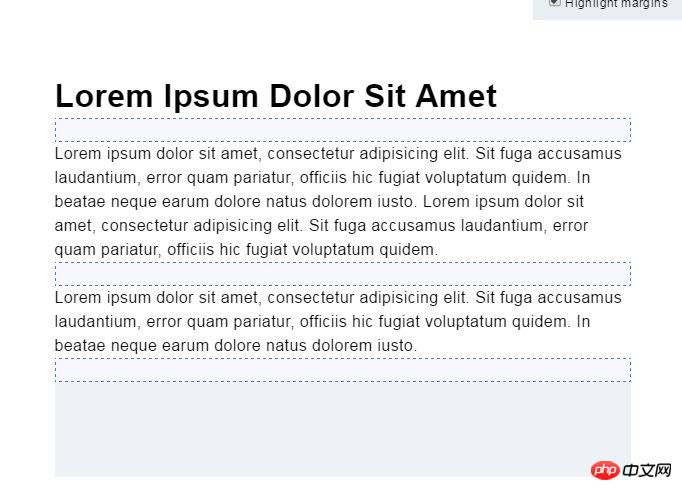
How the sibling selector can keep CSS readable while completing complex design requirements
This is one of the examples in the web front-end development process that starts simple and gradually becomes more complicated: converting an article Vertical margins (vertical margins) should be applied to all elements in the document, such as blog posts compiled from complex markdown.
In most cases, you have to deal with a lot of exceptions and correlations, such as: titles and images usually require more white space above and below, but if two images are next to each other, then the two images will The white space will change less. The direct distance between the h2 tag and the h3 tag is smaller than the distance between the two h2 tags.
When the original author first started doing front-end a few years ago, all these exceptions and dependencies always resulted in complex code, visual inconsistencies and unexpected behavior. I googled many times why margin-top doesn’t work.
The simple html is as follows:
<article class="article">
<h1>Hello World</h1>
<p>Lorem ipsum dolor sit amet</p>
<p>Lorem ipsum dolor sit amet</p>
<img src="…" alt="…">
<p>Lorem ipsum dolor sit amet</p>
<ul>
<li>Lorem</li>
<li>Ipsum</li>
<li>Dolor</li>
</ul>Usually take out two paragraphs to adjust the vertical margin between them to achieve After the desired effect, use this value as the base margin for all elements.
.article > * + * {
margin-top: 1.5rem;
}The above css code adds margin-top to all child elements in .article that have adjacent sibling elements. Only adding margin-topattribute to direct elements avoids unwanted effects. For example, margin-top will be added to ul in the above html instead of li.

In this step, more specific css rules will be added, such as:
.article > img + * {
margin-top: 3rem;
}Any element after img will receive a specific margin-top, the effect is similar to applying margin-bottom directly to img. But using adjacent sibling selectors and margin-top has two advantages:
1. Not having to removemargin-bottom
from the last child 2. And Avoid collapsing margins.

In this step, add the rule to a specific element, for example:
.article > * + h2 {
margin-top: 4rem;
}
.article > * + img {
margin-top: 3rem;
}h2 and img that have adjacent siblings will receive a specific margin-top.

In this last step, handle styles with special correlation
.article > img + img {
margin-top: 1rem;
}Change the distance between adjacent images

If necessary, you can also add a precise css selector, such as:
.article > img + img + img + h2 {
margin-top: 5rem;
}If an h2 is arranged in three consecutive Image, it will receive a specific margin-top. Fortunately, this is just a special case, but it's nice to know that adjacent sibling selectors can solve this complex dependency problem.
To improve readability, use (SCSS) nesting and write each rule on one line. There is no need to group selectors with the same value, as CSSO will handle this later in the build task.
.article {
> * + * { margin-top: 1.5rem }
> h2 + * { margin-top: 1rem }
> img + * { margin-top: 3rem }
> * + h2 { margin-top: 4rem }
> * + h3 { margin-top: 3.5rem }
> * + img { margin-top: 3rem }
> img + img { margin-top: 1rem }
> h2 + h3 { margin-top: 4.5rem }
}This technique also works with SASS or CSS, such as the baseline grid. If all margins are calculated from a specified marginvariable, you only need to change the variable to increase or decrease the overall margin.
Generally when developing a website, you will encounter very complex articles, which usually include elements such as category titles, Introduction text or nested layouts. Using adjacent sibling selectors and a unique margin-top can solve complex design requirements while keeping CSS understandable, making it easier to add or adjust rules later.
【Related recommendations】
1. Free css online video tutorial
3. php.cn Dugu Jiujian (2)-css video tutorial
The above is the detailed content of Example code for sibling selector to implement vertical margins. For more information, please follow other related articles on the PHP Chinese website!
 Which platform is better for virtual currency trading?
Which platform is better for virtual currency trading?
 oicq
oicq
 How to represent negative numbers in binary
How to represent negative numbers in binary
 How to delete a folder in linux
How to delete a folder in linux
 Linux find command usage
Linux find command usage
 What is the difference between hardware firewall and software firewall
What is the difference between hardware firewall and software firewall
 What is the function of Huawei nfc?
What is the function of Huawei nfc?
 How to modify the text on the picture
How to modify the text on the picture




